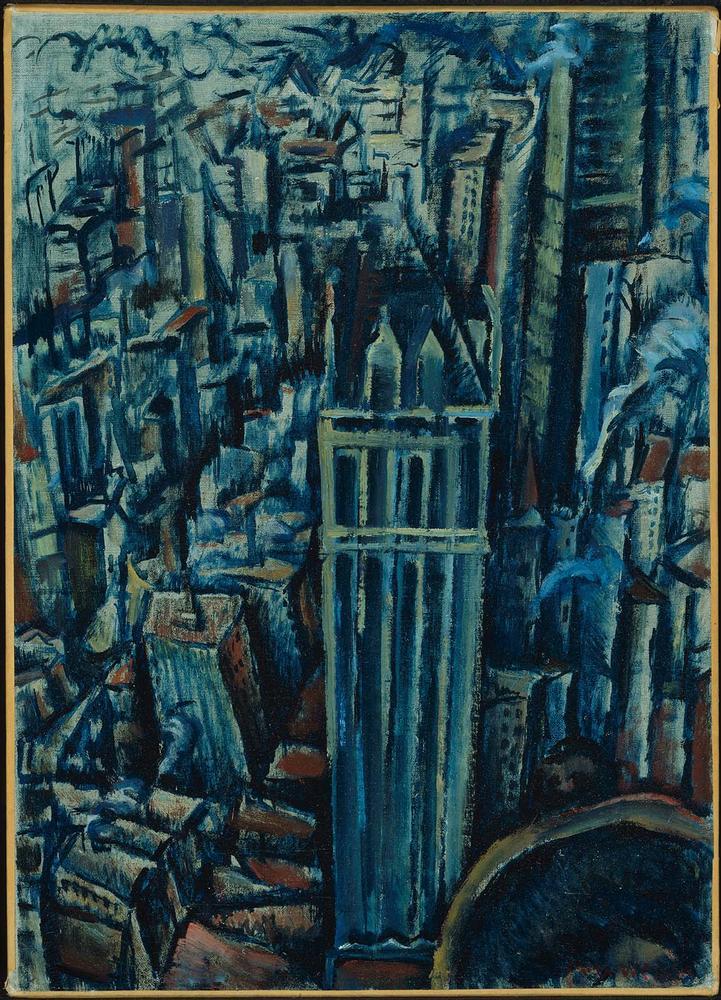Advanced Search 

New York (The Liberty Tower from the Singer Building)
Max Weber (American (born in Russia), 1881–1961)
1912
Medium/Technique
Oil on canvas
Dimensions
46.35 x 33.34 cm (18 1/4 x 13 1/8 in.)
Credit Line
Gift of the Stephen and Sybil Stone Foundation
Accession Number1971.705
NOT ON VIEW
CollectionsAmericas
ClassificationsPaintings
In the early twentieth century, New York's dynamic skyline represented the essence of the new, modern world. Buildings rose to unprecedented heights made possible by new technologies. An economic boom spurred rapid growth and constant construction, which transformed old neighborhoods. Max Weber portrayed this rapidly changing city in this view looking down at the Liberty Tower, a slender thirty-three-story skyscraper, from the even taller Singer Building, one block away.
Construction began on Liberty Tower in 1909, the year Weber returned to the United States after study in Europe. Architect Henry Ives Cobb disguised its steel structure with white terra-cotta neo-gothic ornamentation. Weber, however, emphasized the skyscraper's slender shape rather than its decorative surface, simplifying it by eliminating both the decoration and the peaked copper roofs that lend the building its distinct appearance. What remains in Weber's image is an attenuated tower with an irregular, broken façade--not gothic or geometric, but uneven, like a hand carved post. Using a small canvas--jjust over eighteen inches in height--Weber conveyed the powerful totemic presence of Liberty Tower set against the confusion of the city. Weber's heavy, jagged outlining of the jumbled urban architecture suggests both the physical anatomy of the city and the frenetic activity of its people.
Innovative in both subject and style, New York confirms Weber's status as an original American painter and a conduit for avant-garde European art practices. The fractured forms of the city and the dramatically distorted perspective demonstrate Weber's familiarity with the adventurous experiments of the Cubists. While vertigo-inducing views became a staple of Modernist photography (and popular films) in succeeding decades, such extreme perspectives were nearly unheard of in any medium in 1912. It was far more common for artists to portray skyscrapers from the ground towering above the viewer. Weber, with his friend photographer Alvin Langdon Coburn, was at the forefront of American modernists searching for novel representations of the urban landscape. Coburn's photograph of Liberty Tower from the Singer Building [http://www.geh.org/fm/coburn/alcoburn/m196701440293_ful.html], made the same year as Weber's painting, retained the Gothic detail of Cobb's design and was cropped so the Tower fills the frame from top to bottom. Weber, instead, exaggerated the perspective to include more of the city. Manhattan becomes an energized space surrounding Liberty Tower, as if to illustrate Weber's concept of a "fourth dimension." In a 1910 Camera Work article Weber defined the fourth dimension as "the consciousness of a great and overwhelming sense of space-magnitude in all directions at one time." "It is," he wrote, "the space that envelopes a tree, a tower... It arouses imagination and stirs emotion. It is the immensity of all things."
Liberty Tower still stands at the intersection of Liberty and Nassau Streets; the Singer Building was demolished in 1968, to be replaced by One Liberty Plaza.
Cody Hartley
Construction began on Liberty Tower in 1909, the year Weber returned to the United States after study in Europe. Architect Henry Ives Cobb disguised its steel structure with white terra-cotta neo-gothic ornamentation. Weber, however, emphasized the skyscraper's slender shape rather than its decorative surface, simplifying it by eliminating both the decoration and the peaked copper roofs that lend the building its distinct appearance. What remains in Weber's image is an attenuated tower with an irregular, broken façade--not gothic or geometric, but uneven, like a hand carved post. Using a small canvas--jjust over eighteen inches in height--Weber conveyed the powerful totemic presence of Liberty Tower set against the confusion of the city. Weber's heavy, jagged outlining of the jumbled urban architecture suggests both the physical anatomy of the city and the frenetic activity of its people.
Innovative in both subject and style, New York confirms Weber's status as an original American painter and a conduit for avant-garde European art practices. The fractured forms of the city and the dramatically distorted perspective demonstrate Weber's familiarity with the adventurous experiments of the Cubists. While vertigo-inducing views became a staple of Modernist photography (and popular films) in succeeding decades, such extreme perspectives were nearly unheard of in any medium in 1912. It was far more common for artists to portray skyscrapers from the ground towering above the viewer. Weber, with his friend photographer Alvin Langdon Coburn, was at the forefront of American modernists searching for novel representations of the urban landscape. Coburn's photograph of Liberty Tower from the Singer Building [http://www.geh.org/fm/coburn/alcoburn/m196701440293_ful.html], made the same year as Weber's painting, retained the Gothic detail of Cobb's design and was cropped so the Tower fills the frame from top to bottom. Weber, instead, exaggerated the perspective to include more of the city. Manhattan becomes an energized space surrounding Liberty Tower, as if to illustrate Weber's concept of a "fourth dimension." In a 1910 Camera Work article Weber defined the fourth dimension as "the consciousness of a great and overwhelming sense of space-magnitude in all directions at one time." "It is," he wrote, "the space that envelopes a tree, a tower... It arouses imagination and stirs emotion. It is the immensity of all things."
Liberty Tower still stands at the intersection of Liberty and Nassau Streets; the Singer Building was demolished in 1968, to be replaced by One Liberty Plaza.
Cody Hartley
InscriptionsLower right: MAX WEBER
ProvenanceThe artist; with The Downtown Gallery, New York; to Stephen and Sybil Stone; to Stephen and Sybil Stone Foundation; to MFA, 1971, gift of Stephen and Sybil Stone Foundation.
Copyright© Museum of Fine Arts, Boston
